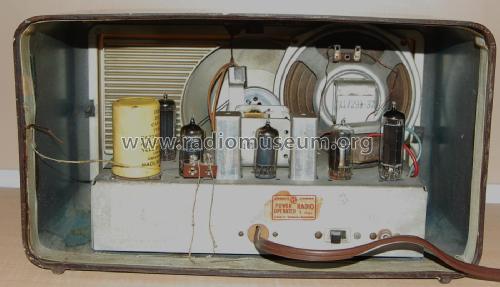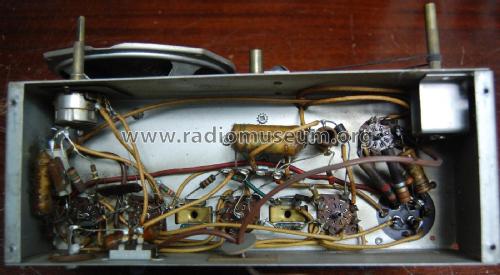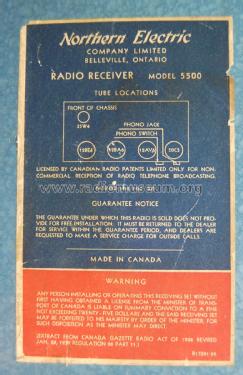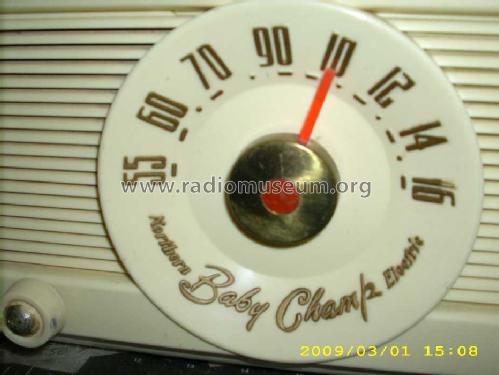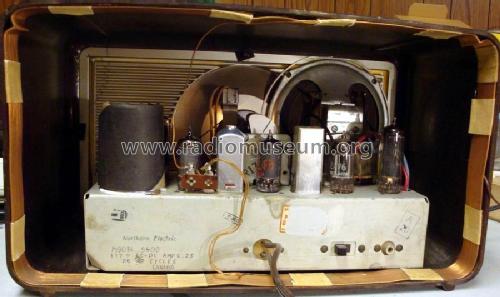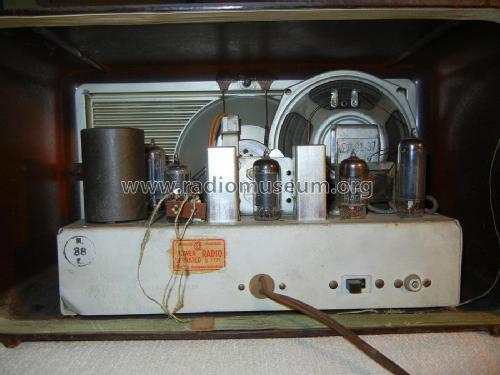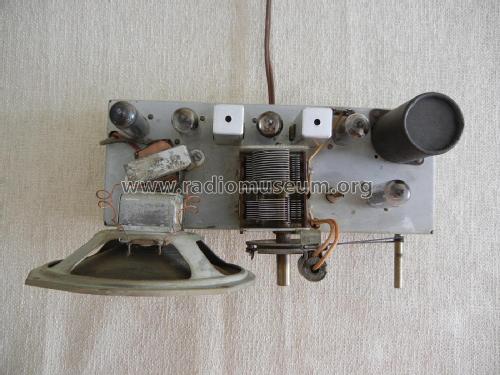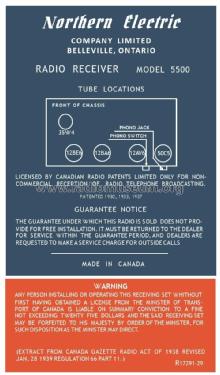Baby Champ 5500
Northern Electric Co. Ltd.; Montreal, QC ; Belleville, ON
- Country
- Canada
- Manufacturer / Brand
- Northern Electric Co. Ltd.; Montreal, QC ; Belleville, ON
- Year
- 1951
- Category
- Broadcast Receiver - or past WW2 Tuner
- Radiomuseum.org ID
- 148209
Click on the schematic thumbnail to request the schematic as a free document.
- Number of Tubes
- 5
- Main principle
- Superheterodyne (common); ZF/IF 455 kHz
- Tuned circuits
- 6 AM circuit(s)
- Wave bands
- Broadcast only (MW).
- Power type and voltage
- AC/DC-set / 117 Volt
- Loudspeaker
- Permanent Magnet Dynamic (PDyn) Loudspeaker (moving coil) / Ø 5 inch = 12.7 cm
- Power out
- 1.9 W (unknown quality)
- Material
- Plastics (no bakelite or catalin)
- from Radiomuseum.org
- Model: Baby Champ 5500 - Northern Electric Co. Ltd.;
- Shape
- Tablemodel without push buttons, Mantel/Midget/Compact up to 14
- Dimensions (WHD)
- 12 x 7.5 x 7 inch / 305 x 191 x 178 mm
- Notes
- Built-in antenna. Speedometer dial. Equipped with Phono-Jack and Phono/Radio Switch.
Plastic cabinets in Blue, Ivory, Green, Brown, Rose and White.
- Source of data
- -- Original prospect or advert
- Circuit diagram reference
- Radio College of Canada
- Literature/Schematics (1)
- Northern Electric Suppl. Pages 55, 56, 59
- Author
- Model page created by Franz Scharner. See "Data change" for further contributors.
- Other Models
-
Here you find 291 models, 246 with images and 254 with schematics for wireless sets etc. In French: TSF for Télégraphie sans fil.
All listed radios etc. from Northern Electric Co. Ltd.; Montreal, QC ; Belleville, ON
Collections
The model Baby Champ is part of the collections of the following members.
Forum contributions about this model: Northern Electric Co: Baby Champ 5500
Threads: 1 | Posts: 2
( Posted with kind permission of our honest member John Bartley. Thank you very much, John )
[ Remark from GR: Not dedicated to a special model of Northern Electric, because the chassis is used in many of their "Baby Champ" models ]
This is a pictorial example of the procedure which I have used to
repair intermediate transformers in which the capacitors are suffering
from silver migration.
1) Start by identifying the radio. Look for a model number on the
chassis or cabinet, or if that is a no-go, get the tube list, take a
photo if possible, and post the tube info and radio description on an
antique radios "newsgroup" or "forum". Someone is sure to help. The idea
is to get the values for the I.F.capacitors, and hopefully from a
schematic. If this is not possible, and if no-one is able to help with
identifying the values, then you're going to have measure the inductance
of each individual coil, and calculate the capacitance using formulas
for capacitive and inductive reactance at the I.F. frequency.
Now that we've scared you to death with the possibility of having to
know the theory and math behind resonance, have a look at the following
mechanics of the operation.
Typical model number:
2) Identify the offending transformer (this one looks suspicious)
Usually this is done either by using a modulated signal generator and
your ear, or a signal generator and an oscilloscope to trace backwards
from the audio stage, until you pass a stage where there is no more
noise either audible or viewable on the scope.
Typical intermediate frequency transformer:
3) Be sure that you're unsoldering the correct transformer, that it is
indeed an IF transformer, and don't get them backwards when you flip the chassis over ( this leads to expressive language later!).
The transformer bases are sometimes marked with one or more coloured dots to identify what the connections are, and where they go.
If your schematic is not coded, or the transformer has no marks, it's a good idea to mark the transformer, and your schematic, and possibly even the chassis (for orientation) so as to make the reassembly easier. (Especially if you have to wait a while for the capacitors, and have a tendancy to forget like I do!)
IF xfrmr bottom side:
4) This next photo is what the transformer looks like before it is
pulled apart. Now for those of you who take things literally, "pulling"
is a relative term. "Gently disassemble" is probably more accurate.
Note: the clip is taken off before you remove the can from the chassis.
It's true, I wouldn't lie to you.
IF xfrmr out of chassis: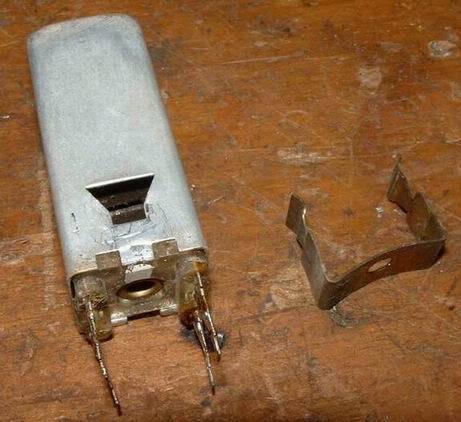
5) Following is the transformer out of the can, but with the brass rivet
still holding the parts of the capacitors together. I've found that the
best way to remove the rivet is with a very sharp drill bit and light
pressure, but high speed on the bit. Others have had better success
using a hot soldering iron to the melt the rivet out of the plastic base
plate. This method may be easier if you are not able to drill cleanly
and carefully. The soldering iron method involves putting the round tip
from a hot soldering iron into the hole in the rivet, and pushing gently
while the heat from the iron melts the plastic around the rivet. The
rivet will push up into the framework of the transformer, and then can
be picked off the soldering iron tip with a pair of needle-nose pliers.
Cover taken off IF xfrmr:
6) Here it is with the rivet drilled out, and the plastic capacitor
retainer plate removed. All that is left are the two top contact strips,
the mica spacer/insulator, and the two lower contact strips (not visible
under the mica).
Rivet drilled out - cover plate off capacitor:
7) And once again, this time with the mica out and both contact strips
showing. Lots of migration showing in this puppy! It was going to need a
passport soon!! Maybe even some unemployment insurance!
Capacitor mica removed:
8) To keep the contact strips from touching, I curl them a bit. If the
replacement caps WON'T fit in the can, then I glue (hot or epoxy) the
strips tight into place, and solder the replacement caps onto the
underside after the transformer is reinstalled into the chassis. If the
replacement caps DO fit in the transformer, then..........see the next
photo.
Ready for new capacitor:
9) This is "any old capacitor" which I used for the photo. It's now
soldered into place and ready to go back together. In your radio, make
sure that you have the correct value. You can test these transformers
and capacitors out of the radio by putting an RF signal of the correct
frequency (obviously) through the primary coil, and hooking your scope
across the secondary using a detector probe. With this hookup, you can
verify that the circuit resonates properly, and you can also peak the
transformers before they go back into the radio.
New capacitor soldered into place:
10) Here we have the transformer with new capacitors installed and the
assembly slid back into the can, with the metal retaining tabs bent back
into place.
IF xfrmr assembled - ready to reinstall into chassis: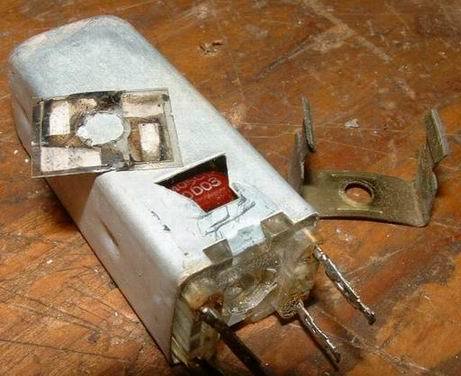
11) This shows how the clip will attach to the transformer and hold it
into the chassis. It's probably a good idea to put the transformer into
the chassis before installing the clip! It's easier that way!
How retainer clip fits:
Georg Richter, 01.Jun.06




